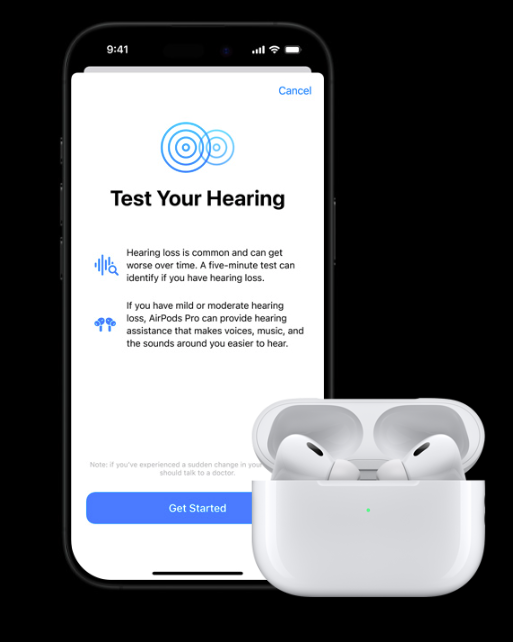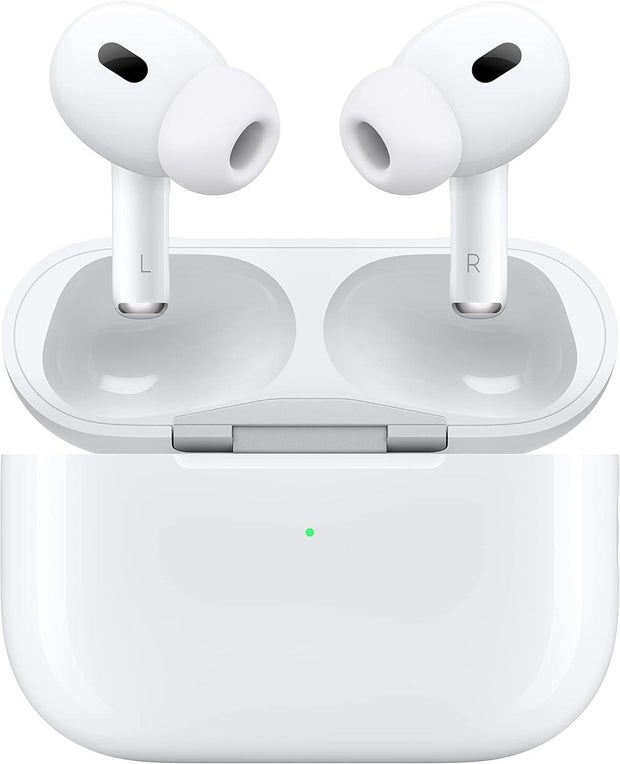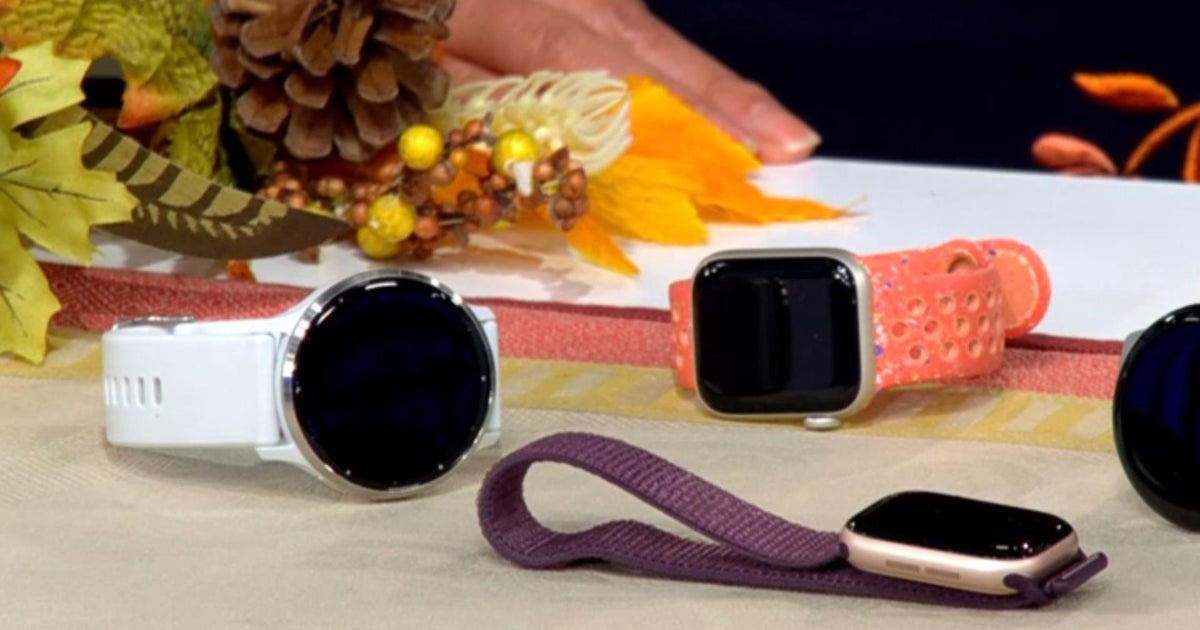CBS News
Are Apple AirPods also hearing aids? What you need to know about Apple’s new groundbreaking health features

Apple
Apple announced a handful of new products at its “It’s Glowtime” fall product reveal this week, including the iPhone 16 smartphone and Apple Watch 10. But one of the biggest pieces of news to come from Apple’s event wasn’t about a new product, it was about the new hearing aid functionality coming to the company’s Apple AirPods Pro 2 earbuds this fall.
The free upgrade will happen via software update. That means existing Apple AirPods Pro 2 earbud owners will be able to take advantage of the new hearing aid and hearing protection features without needing to buy new headphones. (The hearing aid feature does, however, require you to pair the AirPods Pro 2 to an Apple iPhone.)
Want to know how Apple AirPods Pro 2 might be able to help you or a family member with mild to moderate hearing loss? Read on — our CBS Essentials tech experts explain the need-to-know details.
Can Apple AirPods Pro 2 really be used as hearing aids?
Apple
Apple is currently working with the FDA to release an update to the AirPods Pro 2 that’ll allow the earbuds to work as over-the-counter hearing aids and hearing protectors.
Experts are already calling the new hearing aid feature a game changer. While you could easily spend $500 to $1,000 or more for over-the-counter hearing aids from other brands, Apple AirPods Pro 2 retail for just $249 (and can frequently be found on sale for under $200).
To take advantage of the soon-to-be-released hearing aid functionality, you’ll need to pair your Apple AirPods Pro 2 with an Apple iPhone. From your iPhone, you can then participate in a clinical-grade home hearing test that will determine your level of hearing loss, if any. Based on your test results, the AirPods Pro 2 will automatically be configured to your level of hearing loss, and can serve as hearing aids when worn in everyday situations.
Note: The hearing test offered by your iPhone is not a replacement for one performed by an audiologist or ear, nose and throat specialist. You should consult your own doctor first if you believe you have hearing loss.
When you use the earbuds to listen to music or participate in hands-free phone calls, the AirPods Pro 2 will automatically adapt to your hearing level. The active noise-canceling earbuds reduce ambient sounds so you can experience crystal-clear and easy-to-understand audio in almost any situation. The earbuds can also act as hearing protectors, reducing extremely loud noises that can cause hearing damage.
You can manually fine-tune amplification and tone anytime when using the AirPods Pro 2 as an over-the-counter hearing aid. You can also let the iPhone and AirPods to make adjustments automatically, without you having to tinker with any iPhone or AirPod controls.
How do you use the AirPods Pro 2 hearing aid feature?
Apple
First, you will need to download and install the latest version of iOS 18 on your iPhone which will have the at-home hearing test functionality. It will also be necessary to update the firmware on your AirPods Pro 2 wireless earbuds. Both updates will be free.
Once installed, you can activate the Hearing Aid and Hearing Protection features that will be integrated into the AirPods.
Setting up the AirPods Pro 2 to work as hearing aids will require you to complete the hearing test on your iPhone. This can be completed in just a few minutes. After completing the test, your iPhone will display your personalized hearing profile and walk you through the process of setting up the AirPods Pro 2 as hearing aids.
The settings within the AirPods will be adjusted automatically to match your personal needs. All of your hearing test data is stored locally and privately, within the iPhone’s Health app. You can take the hearing test as often as you’d like. You can also share the results with your audiologist or doctor.
How much do the AirPods Pro 2 cost?
The suggested retail price of Apple AirPods Pro 2 is $249, and that’s what you’ll pay for them at the Apple Store. However, popular retailers, like Amazon, Best Buy, Walmart and Target frequently put them on sale for $200 or less. This makes them an excellent budget hearing aid option.
Hearing aid functionality will be added as a free software upgrade to the Apple AirPods Pro 2.
What are some of the other health features Apple added?
The new iPhone 16 smartphones and Apple Watch Series 10 smartwatches are chock full of new and enhanced health, fitness and safety features. At the same time Apple is updating the AirPods Pro 2 so they can be used as over-the-counter hearing aids. A new feature, called Hearing Protection, will also be unlocked.
Anytime you’re wearing the earbuds once the firmware update has been installed, they will monitor the ambient sounds around you at a rate of more than 48,000 times per second. When the AirPods pick up loud and potentially unsafe sounds — if you’re at a loud concert, sitting next to a screaming baby, mowing your lawn, or walking past a construction site, for example — the AirPods Pro 2 will use their built in technologies to automatically reduce the sounds to a safe volume. The sounds you want to hear will continue to be natural, clear and vibrant.
The AirPods Pro 2 offer pro-level noise cancellation; adaptive audio that customizes the sounds you hear based on your environment; adaptive EQ; a conversation boost mode that helps you better focus on and hear voices when people are speaking; and the ability to adjust sound volume. Plus, at your discretion, you can play calming sounds, like ocean waves or rainfall, to help mask unwanted environmental noise.
If you access the Accessibility menu found in Settings on your iPhone, you’ll discover more ways to custom-configure your phone and earbuds to cater to your unique needs.
Apple AirPods Pro 2 offer premium audio for everyone
Apple
Release date: 2022 | Battery life: Up to 6 hours | Battery life with case: Up to 30 hours | Wireless charging: Yes | Driver size: 11mm | Quick charge: 5 mins in case offers up to 1 hour additional listening/talk time | Charging port on case: USB Type-C | Water & sweat resistant: IP54 | Spatial audio with dynamic head tracking: Yes | Active noise cancellation: Yes | Adaptive audio: Yes | Conversation awareness: Yes | Earbud dimensions: 1.22 x 0.86 x 0.94 inches | Earbud weight: 0.19 ounces | Case dimensions: 1.78 x 2.39 x 0.85 inches | Case weight: 1.79 ounces | Wireless connectivity: Bluetooth 5.3 | Audio chip: Apple H2 | Hearing aid and hearing protection functionality: Yes
With these earbuds, you get features like adaptive audio, pro-level active noise cancellation, a transparency mode, a conversation awareness feature and onboard touch controls. Other notable features include voice isolation, personalized volume, adaptive EQ and loud sound reduction. These AirPods are IP54 rated for dust, sweat and water resistance, so you can definitely wear them at the gym or while working out.
The pro-level active noise cancellation feature does a really good job drowning out (and often eliminating) ambient noise, even when you’re not listening to audio. When you are listening to music or audio that supports it, the ANC works in conjunction with the spatial audio (with dynamic head tracking) feature to deliver lossless audio with ultra-low latency. As a result, the high fidelity audio these AirPods produces is far more immersive, robust, and lifelike than what’s offered by most other earbuds.
And thanks to the Adaptive Audio feature, Conversation mode and Transparency mode, you can retain some situational awareness or converse with people in the real world when needed. The audio you’re listening to and ANC will adapt automatically, allowing you to have a conversation with someone nearby, while ANC still works in the background to reduce unwanted loud noises. Meanwhile, these earbuds learn and adapt to your personal preferences when you’re using them in various environments. As a result, you’ll enjoy your customized audio options without having to tinker with the controls.
Another feature we really like that’s built into the AirPods Pro 2 earbuds are the touch controls you can utilize by tapping or sliding your finger along the step of an earbud. Of course, you also get the seamless switching between Apple devices and access to Siri (and Apple’s latest AI functionality offered by Siri). Plus, you get the option to have Siri read incoming text messages or emails, or alert you of urgent app-specific notifications while you’re wearing these AirPods.
Pro Tip: For help choosing the best Apple AirPods model to meet your needs and budget, check out our newly-updated 2024 Apple AirPods buyer’s guide.
Will other Apple AirPods models get a hearing aid feature?
This hearing aid and hearing protection update will be for all AirPods Pro 2 earbuds only. Hearing aid and hearing protection functionality will not be offered for the AirPods 4, AirPods 4 with Active Noise Cancellation, or the AirPods Max headphones.
CBS News
Takeaways from Trump’s first post-election news conference

Watch CBS News
Be the first to know
Get browser notifications for breaking news, live events, and exclusive reporting.
CBS News
The health stories that shaped 2024

Watch CBS News
Be the first to know
Get browser notifications for breaking news, live events, and exclusive reporting.
CBS News
Nearly half of U.S. teenagers say they’re online almost constantly, survey finds

Watch CBS News
Be the first to know
Get browser notifications for breaking news, live events, and exclusive reporting.











